The Most Beautiful Village in the World
 November 14th, 2018 by jules
November 14th, 2018 by jules
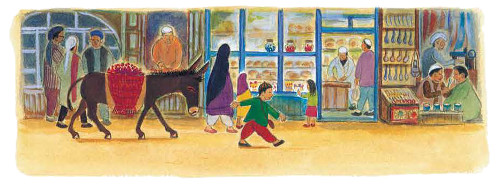
On shelves now, dedicated to “the children of Afghanistan,” is a picture book originally published in Japan in 1995 but brought here to the States (as the first book in a series) just last month — Yutaka Kobayashi’s The Most Beautiful Village in the World (Museyon, October 2018). This unusual picture book gives child readers a glimpse into life in Afghanistan, specifically the village of Paghman.
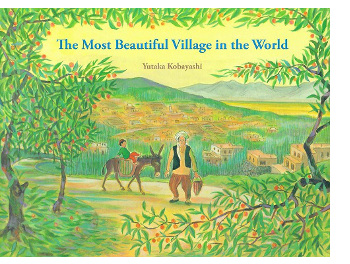 Spring in Paghman quickly turns to summer, and apricots, plums, and cherries bloom. It’s harvest time. Young Yamo usually joins his brother Haroon to pick fruit, but Haroon is at war in the very country in which they live. Instead, Yamo joins his father and their donkey (named Pompa) to sell fruit. Readers follow them on their journey through the countryside and into town, taking in the beauty of the land as depicted in Kobayashi’s intricate, detailed, and brightly colored spreads, some of which you can see below. We meet townspeople; smell the bread baking; and take in the sights of the bustling bazaar, as Yamo goes to sell cherries on his own, while his father stays to sell plums in the plaza. Yamo overcomes his anxiety of selling alone and comes to a place of pride when all of the cherries are eventually sold. With the money they’ve earned, Yamo’s father surprises him with the purchase of a young lamb. The boy is thrilled: “No one else in their village has such a beautiful lamb.”
Spring in Paghman quickly turns to summer, and apricots, plums, and cherries bloom. It’s harvest time. Young Yamo usually joins his brother Haroon to pick fruit, but Haroon is at war in the very country in which they live. Instead, Yamo joins his father and their donkey (named Pompa) to sell fruit. Readers follow them on their journey through the countryside and into town, taking in the beauty of the land as depicted in Kobayashi’s intricate, detailed, and brightly colored spreads, some of which you can see below. We meet townspeople; smell the bread baking; and take in the sights of the bustling bazaar, as Yamo goes to sell cherries on his own, while his father stays to sell plums in the plaza. Yamo overcomes his anxiety of selling alone and comes to a place of pride when all of the cherries are eventually sold. With the money they’ve earned, Yamo’s father surprises him with the purchase of a young lamb. The boy is thrilled: “No one else in their village has such a beautiful lamb.”
The final wording, on a spread with no art, is stark and sudden: “In the winter, the village was destroyed in the war. It no longer exists.” It’s a reality for many children the world over and will be eye-opening for many American children. As the Booklist review notes,
Mainstream sources of information don’t provide many ways for us to visualize Afghanistan as anything other than a dusty, war-ravaged place of despair. And while there may be some truth to that, there is another side to this country and its people.
This book provides that glimpse. In a closing note from the author, he explains that he modeled this village on one of his own trips to Afghanistan, during which he made friends with those in a small village, adding that it was “later bombed and ruined. I do not know what happened to the friends I made in that village.”
The village of Paghman is filled with flowers.”
(Click to enlarge spread)

(Click to enlarge spread and see text in its entirety)
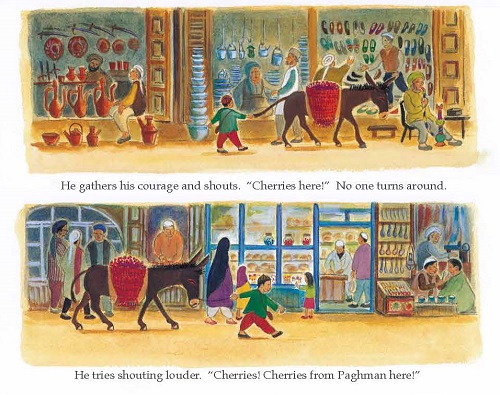

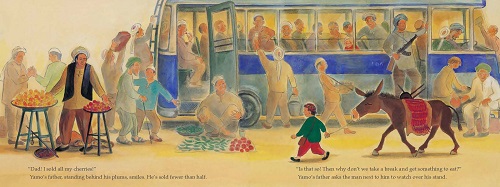
(Click to enlarge spread and read text in its entirety)

(Click to enlarge spread and read text in its entirety)
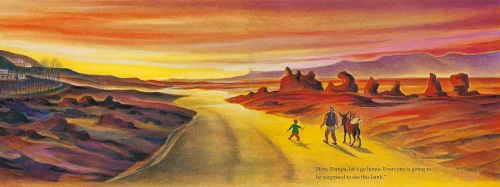
be surprised to see this lamb.'”
(Click to enlarge spread)
THE MOST BEAUTIFUL VILLAGE IN THE WORLD. Sekaiichi Utsukushii Boku no Mura
© 1995 Yutaka Kobayashi. Originally published in Japan in 1995 by POPLAR Publishing Co., Ltd. English translation rights arranged with POPLAR Publishing Co., Ltd. Illustrations reproduced by permission of the publisher, Museyon Inc., New York.
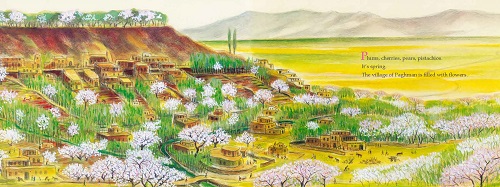

Do the scars of wars, like scars from fire, ever grow over and become green and flourishing again? Carl Sandburg assured us that the grass would cover battlefields… but from modern warfare that isn’t WWI, what will return?
Sometimes the Middle Eastern lands which have been so utterly ruined make me ill. I am so glad someone remembers the beauty and is willing to remind others that Afghanistan isn’t entirely ugly and filled with war.
Amen.